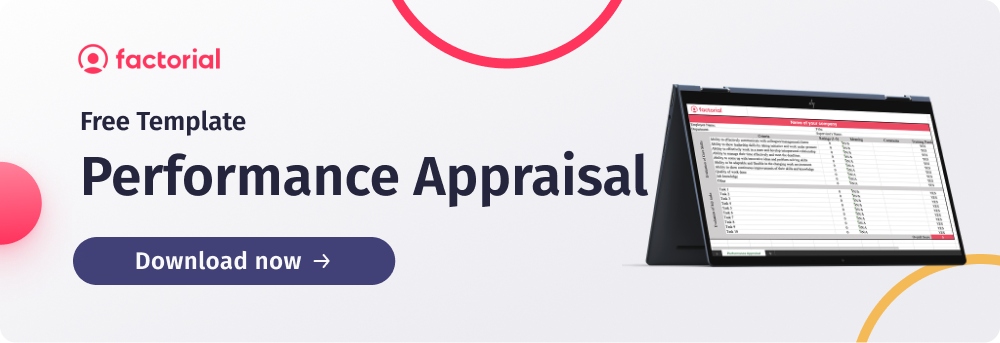An attrition rate is a method used to calculate the level of employees that leave the company in any given period of time. Whereas turnover measures overall departures from an organisation, the attrition rate calculates the number that leave and are not immediately replaced.
In this post, we will look at what the terms mean for you as an employer, and why employee retention is so important. We will also look at the effect employee satisfaction can have on attrition and retention rates and what you can do to improve numbers in your organisation. Finally, we will discuss how software solutions can help you better manage and track employee morale and performance to help you obtain optimum attrition rates at your company.
✅Download Factorial’s Performance Appraisal Template
Attrition Rate Definition
The attrition rate, also known as churn rate, is a measurement of how many employees leave a company and are not replaced in a given period. The rate is shown as a percentage compared to the total workforce. It serves as a tool to see how efficient your company is at replacing employees that leave voluntarily and involuntarily. You can also use it to detect problem areas in your organisation that might be affecting overall manpower. Learning to understand attrition can help your business decrease turnover and increase retention and performance.
The first step is understanding the different types of attrition:
- Attrition due to retirement: when a sizable number of employees retire at the same time.
- Voluntary attrition: when employees voluntarily hand in their notice (most common type of attrition).
- Involuntary attrition: when you dismiss an employee for whatever reason (misconduct, structural reasons, etc.).
- Internal attrition: when employees quit their jobs to join another department within the company.
- Demographic-specific attrition: when notable rates of employees from a single group (women, ethnic minorities, people with disabilities, older professionals, etc.) leave the company.
Calculating Your Attrition Rate
To find out your company’s employee attrition rate you need to multiply the number of employees who have left (in a given period) by your average number of employees (for that same period), then multiply the result by 100.
The formula looks like this:
Attrition rate (%) = (number of leavers / number of employees) x 100
For example: You want to calculate the attrition rate for last year. Let’s say your company started the year with 100 employees. Throughout the year, 20 employees left the company (voluntary and involuntary) and there were 4 new hires.
The first step is to calculate the number of employees at the end of the year:
100 – 20 + 4 = 84
Then calculate the average number of employees for that year:
(100+84) / 2 = 92
You can now calculate the attrition rate for the whole year as follows:
Attrition rate (%) = (20 / 92) x 100 = 21.7%
A high rate means that your employees are leaving frequently, while a low rate indicates that you’re keeping your employees for longer periods of time.
Attrition HR: What It Means For You
Most employers want a low attrition rate because it means that employees are happy, and happy employees perform better. Lower attrition rates also convert into higher retention levels. This results in reduced training and onboarding costs. It also means that you can focus on building your business rather than recruiting, onboarding and training replacements.
Attrition in HR is an important metric for detecting weak areas you may need to address to increase employee retention. This is especially true when it comes to voluntary attrition as it is your job to find out why people have resigned from their post. You might discover that there is a high rate of attrition at a senior level. This could lead to leadership gaps and affect the level of support that junior members of staff receive. Or perhaps you discover an alarming rate of demographic-specific attrition in a certain department (such as women never being promoted in sales), which could be down to a hostile work environment. Other reasons for attrition might include a lack of opportunities for professional development and weak leadership.
As an HR professional, the best way for you to improve attrition and retention rates is to nurture and motivate happy employees. Conduct detailed exit interviews and collect feedback from employees using surveys. Are you providing employees with sufficient training and career development opportunities? Could there be any gaps in the employee experience? Are there any issues with weak leadership or hostile working environments? And if your rates continue to be high, consider fine-tuning your job descriptions and reviewing your recruitment and onboarding processes. This will help you find candidates that are better suited to the job.
Employee Retention: Why It Matters
The retention of employees is important for a number of reasons. Firstly, having a high rate of turnover can be time consuming and costly. For every new recruit, you must review CVs, screen candidates and conduct interviews. Then once you have made an offer to a candidate, you need to onboard and train them. Not to mention all the paperwork and costs involved when someone leaves your company such as exit interviews and severance packages. And there is bound to be a drop in productivity, at least for the time it takes for you to find someone to take over all the departing employee’s tasks.
A company with a high rate of employee retention is also likely to attract and retain more qualified talent. This has a lot to do with reputation relating to employee satisfaction and morale. If a candidate knows that you are able to provide a happy and nurturing workplace then it can be very appealing. And for those employees already working at your company, retention can be a huge factor in the employee experience. Consistent staff changes can make it hard for your employees to develop positive working relationships with their co-workers. And employees who stay at a company for longer are often less stressed, more committed to the long-term success of the company, and more productive. They are also more loyal and have a stronger sense of community.
Reasons for A High Attrition Rate
Several different factors can cause a high attrition rate. The most common of these are:
- Pay: employees who feel they are not appropriately compensated for their work are more likely to leave.
- Company culture: organisations with a positive, supportive and inclusive approach to working with their employees are more likely to retain staff.
- Development opportunities: when employees feel that their chances to advance within a company are limited, they are more likely to look for new roles elsewhere.
- Workplace stress: when employees feel the physical and mental impact of working in a role is taking its toll, they are more likely to leave
- Poor leadership and management: lack of trust in senior people can contribute to employees looking to change roles
- Organisational instability: when employees sense that change is coming or that a company is not as secure as it was, it can lead to more significant attrition as people choose to jump ship rather than wait to see what happens
How to Reduce A High Attrition Rate
We’ve discussed how employee retention benefits the business, so how can you reduce your high attrition rate? Here are six tried and tested strategies for encouraging your staff to stay.
- Change your compensation package to make it more competitive, attractive and performance-based.
- Improve the opportunities for career development within the business by investing in training and mentorship programmes, create internal promotion pathways and support upskilling.
- Create a positive workplace culture by making feedback integral to how the company functions and training leaders in emotional intelligence.
- Support a better work-life balance by offering hybrid working models and flexible schedules, and help with mental health and wellbeing through employee assistance schemes.
- Recognise and reward employees to build a culture of appreciation, which makes employees feel valued and less likely to leave.
- Conduct exit interviews to understand why people leave and share your plan to address the issues raised with the remaining workforce.
Performance Management
When it comes to retention rates you always need to consider performance levels. How do rates correlate with overall and individual performance levels? It is one thing to lose an employee who underperforms, but quite another to lose an overperformer. You need a system that is able to calculate the effect of departures on productivity. You also need a tool that measures employee satisfaction levels to help you detect any potential trends that might be affecting turnover. This is where software steps in. A good performance management software solution can help you manage and monitor performance and satisfaction.
With our performance management feature, you can gain insight into every level of your workforce. You can streamline your performance management process with automated and centralised performance reviews. Set individual and team goals that are in line with the aims and values of your company, and motivate employees with the strategic development of their skills. You can also use the feature to manage all your employee satisfaction surveys. Automated cycles request recurring feedback on a monthly, yearly, or customised basis. This is the best way to keep your finger on the pulse of employee morale so that you can retain more employees and maintain lower attrition rates. And the lower your rate, the stronger your workforce will be.




